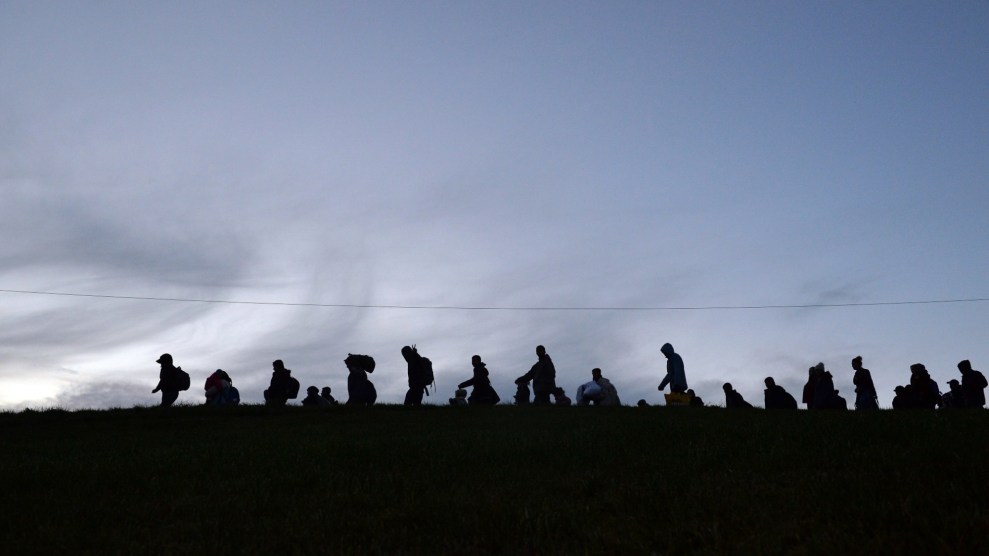
German federal police officers guide a group of migrants between Austria and Germany.Kerstin Joensson/AP
In 1882, the Chinese Exclusion Act, which prohibited the immigration of workers from China for 10 years, became law in the United States. It was the first significant piece of legislation to restrict immigration into the country, and the first time a Western state explicitly shut the door to a specific racial group. As a result, the population of Chinese origin in the United States dropped from an estimated 110,000 in 1890 to roughly 60,000 in 1920. Scholars have described the policy as “the only successful instance of ‘ethnic cleansing’ in the history of American immigration.” Efforts to continue carrying out discriminatory policies did not stop there, however. The Immigration Act of 1924, for instance, established a national origins quota system that limited immigration from nonwhite European countries to preserve “the racial status quo.”
It wasn’t until the mid-to-late-20th century that the United States and other receiving countries stripped their openly racist immigration laws from the books. In their place, these nations implemented what Andrew S. Rosenberg, an assistant professor of political science at the University of Florida, who studies race in international politics, calls a nominally “color-blind” system. In his new book, Undesirable Immigrants: Why Racism Persists in International Migration, Rosenberg explains how racial bias hides in plain sight in immigration policies and practices worldwide. He traces the origins of racist immigration policies that most often affect nonwhite migrants to the creation of nation-states, colonialism, and the expansion of global capitalism. Mother Jones caught up with Rosenberg over the phone on Tuesday, the day his book was published. The interview has been edited for length and clarity:
Happy pub date! How did the idea for the book come about?
The book emerged from my Ph.D. dissertation, which I began working on in 2015, the year of Europe’s so-called migrant crisis. I wanted to see if I could identify whether there was measurable racial inequality in the ability to migrate worldwide. But the problem is that without explicitly discriminatory policies like White Australia [legislation enacted in 1901 to limit non-European migration to Australia], that’s actually a difficult task. I also really wanted to tell a historical story about why this racial inequality can persist in a modern color-blind international system, where states say they have objective immigration policies that only serve the national interest and don’t do any discrimination at all. The way that I squared that circle was to tie modern perceptions of what types of immigrants are desirable or undesirable to long-standing histories of colonial and imperial domination by Western states. It was the Western states throughout history—participating in things like the global slave trade, as well as colonization—that created the immigrants that they so naturally restrict as being undesirable today. That has become exacerbated in the last 20 years or so since 9/11.
In the book, you dispute the assumption that the right to border control and to exclude foreigners is an inherent feature of sovereign states. Instead, you frame it as a “modern consequence of racism.” Why do you see it that way?
The nation-state is a relatively modern invention on the scale of human history. Today, we have this conventional wisdom floating around that it is the natural right and duty of nation-states as sovereign entities to be able to restrict foreigners and have these really hard borders—and that it’s that ability that makes a state what it is. Actually, if you go back in time and look at the international legal thought that emerged from the 15th through the 19th centuries on what it actually means to be a state, the commonly held assumption that people like the late Justice [Antonin] Scalia and others talk about, is actually an invention of the 19th century. In the 16th and 17th centuries, the great thinkers of international legal jurisprudence or of state theory either thought that states had a right or an obligation to be hospitable to foreigners and to allow them free passage into their territory or, at most, it was up for raucous debate. It was only in the 19th century, when immigrant-receiving countries like the United States began receiving a large influx of racially different outsiders like the Chinese, that this presumption that sovereign states have a right and an obligation that can be tied back to their status as sovereign states to restrict outsiders emerged.
People like Texas Gov. Greg Abbott seem to invoke that supposed inherent right when they describe migrants at the border as an “invasion.”
Precisely. These types of “declarations of war” are one of the clearest examples of this ideology seeping into public debate, which leads everyday people to create this idea that migrants are undesirable outsiders who are not fit for, or are undeserving of reaping the benefits of living in the United States or participating in our society.
That idea of the desirable or undesirable migrant recently became very evident in the disparate treatment of Haitian asylum seekers and Ukrainian refugees. How do you explain why countries like Poland, with very strict anti-immigrant policies, welcome those fleeing Ukraine?
They undoubtedly opened their borders out of a sense of solidarity with a group of people who they perceive to be their Eastern European brothers and sisters, for lack of a better expression. In 2015, we saw those same European countries wanted nothing to do with refugees from the Middle East, on the grounds that they were these dangerous, undesirable terrorists. Then seven years later, they were more than willing to accept Ukrainians. People like Trevor Noah and others have said it: There has to be a racialized component to this. Look at the rhetoric around the Ukrainians; they’re educated Europeans, they’re doctors, lawyers, etc. But the perverse thing about framing Ukrainian refugees in that way is that it ignores that Ukraine since the early 1990s has had one of the lowest rates of economic growth in the world, much lower than places like Syria. So if you’re a policymaker really trying to work within the national interest, and you’re trying to be as objective as possible, the refugees from places like Syria would appear to be the most inherently desirable to society, not Ukrainians. Even though, of course, both groups certainly deserve the respect and hospitality that Ukrainians received.
Can you give an example of how the West created the conditions that produced the very “undesirable immigrants” that they now restrict?
One of the really interesting things that emerge when you really dig into the history of immigration policy in the United States, is how many of the debates that we hear in 2022 were really similar to the debates that people were having in the mid to late 19th century. The argument about poor workers from Southern and Eastern Europe who are willing to come to the United States and work for low wages and pollute our society with undesirable traits—there’s certainly a lot of continuity between that moment in American history and today. Workers that came from China were called coolies and were basically a version of indentured servants and indentured workers. And there was a massive worry that these workers were going to come and push down native wages. The fact that these people would come and work for low wages in these dire situations was then used as evidence to suggest that they were unfit for membership in American society. So on the one hand, you have this real exploitation of a nonwhite population, all for the gain of the American capitalist engine. On the other hand, the effects of that exploitation were then used as an ex-post rationale not only to treat these people badly when they were here but also as justification to codify in law this explicitly racist restriction.
Most of the world has moved on from explicitly racist immigration policies like the Chinese Exclusion Act or the 1924 national origin quotas and toward what you call color-blind laws. How did that transition take place?
Some historians and others point to the end of the Second World War as the really defining moment when countries in the West looked to the horrors of the Nazi genocide and at their own immigration policies. In the United States, that provided the momentum that led to things like the [1965] Immigration and Nationality Act [that eliminated the national origins quota system]. I think what we can say is that, in the post-1945 era, the countries that had explicitly racist immigration policies exchanged them for policies with supposedly objective selection characteristics like income or language. The idea that this is how countries ought to choose their immigrants spread like wildfire throughout the world. But the really pernicious thing about policies that produce racial inequality but have the veneer of colorblindness is that you can’t point to them and say, that’s a racist policy. The modern immigration regime, in many ways, is worse because it actually shifts the burden onto the person trying to unmask or expose inequality and discrimination.
You conclude the book on a rather bleak note, saying that “the potent combination of overt, latent, and color-blind racism and the taken-for-granted nature of state sovereignty will likely ensure that restrictive immigration policies are here to stay.” What would it take for countries to change course and enact more open immigration policies?
I created a statistical model for the amount of migration that we should see between every pair of states in the international system from 1960 to 2015—based on things like how far apart two countries are, how rich, how poor, whether two countries are at war, and whether a country is a liberal democracy. What I wanted to do was create baseline expectations based on all of the reasonable factors that we think ought to drive migration between countries in a world in which there was no racial bias or racial discrimination. The statistical model generated predictions, and I compared those predictions to the observed migration flows between countries to show that states from the nonwhite Global South migrated far less than we would expect, and far less than their counterparts in the Global North given this baseline prediction. It actually dovetails nicely with the work of some economists like Michael Clemens and Lant Pritchett, who argue that the fact that there are no open borders is akin to leaving trillion-dollar bills on the sidewalk. Global GDP would be many orders of magnitude higher if we had open borders because a true free market economy for labor would suggest that we should see much more immigration than we actually do.
The issue preventing a more open and accepting immigration regime really can be tied back to this idea that it’s natural and obvious that sovereign nation-states have to restrict their borders in order to be legitimate states that are doing right by their citizens. What borders do in the modern international system is prevent a sense of cosmopolitan empathy within states. It’s really interesting to me that people in rich countries in the West are more than happy to send significant donations every month or every year to causes for helping people in the Global South when the thing that would do most good would be just to open the borders. This actually would provide a massive boost to global economic development. Until the widespread belief that people who, for random, idiosyncratic reasons, just so happened to be born in a country that was not the United States have the right to reap the benefits of living in another country takes hold, I really don’t see this abating. The history of imperialism and global capitalism happened, and the inequalities that we see throughout the world are not likely to vanish in any reasonable amount of time. The people who want to restrict immigration are always going to be able to fall back on the standards of desirability. The only way forward is to keep emphasizing the important role that immigrants play in society.












